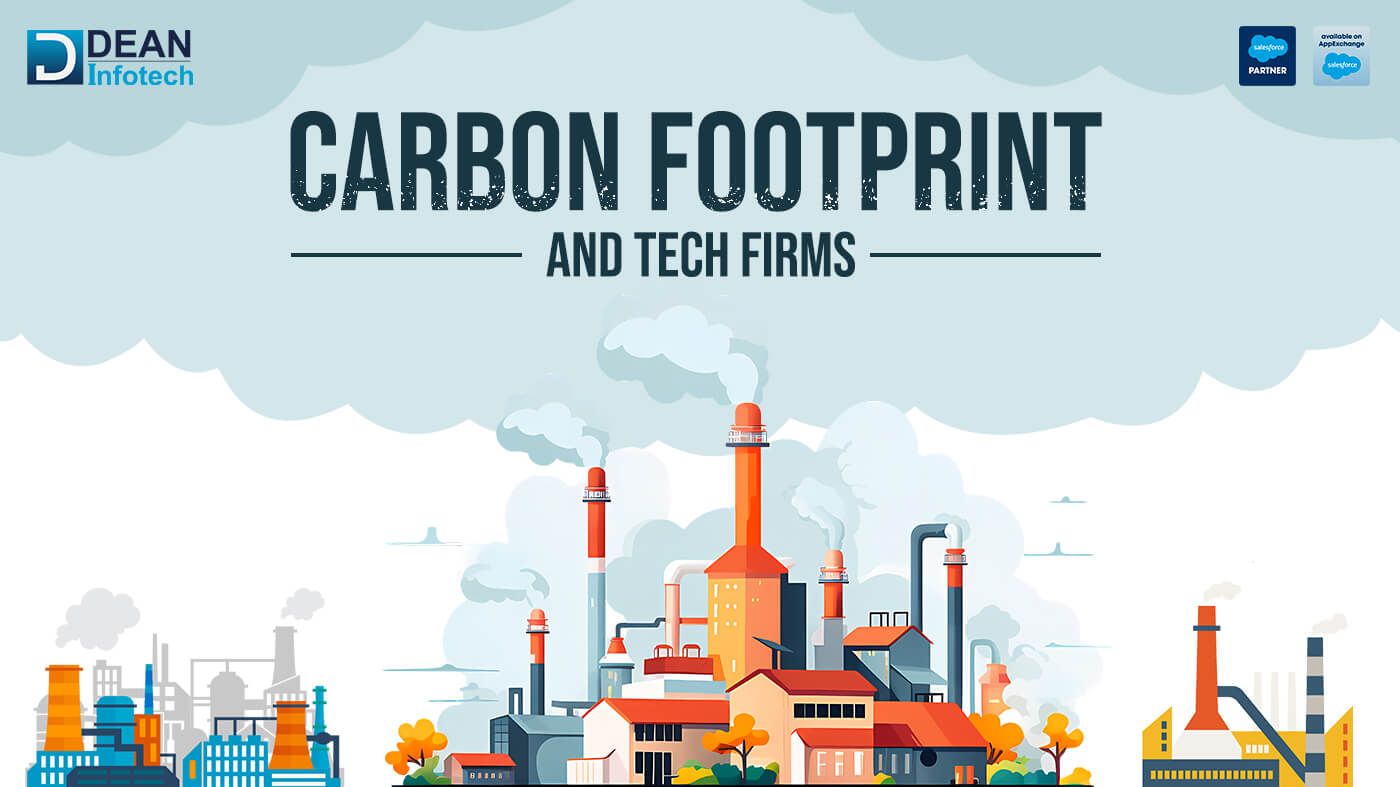Carbon Footprint and Tech Firms
 Ankit Agarwal Monday, May 27, 2024
Ankit Agarwal Monday, May 27, 2024
The tech industry is a double-edged sword when it comes to climate change. On one hand, it's a major driver of innovation with solutions for sustainable energy, smart grids, and remote work reducing commutes. On the other hand, the sector itself has a rapidly growing carbon footprint, fueled by data centers, manufacturing, and e-waste.
This blog delves into the often-hidden environmental impact of tech companies, explores how leading firms are tackling it, and provides practical steps for businesses to assess and reduce their own carbon footprint.
What is the carbon footprint of tech companies?
Tech companies might seem clean, but they leave a significant carbon footprint. The UN estimates the tech industry is responsible for 2-3% of global emissions, on par with aviation. This invisible impact comes from several sources.
- Data centers: The massive facilities storing our information guzzle energy for cooling and running servers.
- Manufacturing: From mining rare earth minerals for gadgets to assembling devices, tech relies on energy-intensive production often overseas.
- E-waste: Rapid device upgrades lead to a growing problem of electronic waste, which can be toxic if not disposed of properly.
- Daily operations: Employee commutes and company offices also contribute to the footprint.
The issue is compounded by our ever-increasing reliance on digital devices and services. Experts predict emissions from tech will soar if not addressed.
There's a silver lining. Tech companies have the potential to be sustainability leaders. By investing in renewable energy sources for data centers, designing more energy-efficient devices, and promoting responsible e-waste disposal, the tech industry can revolutionize climate action.
Top and Successful Tech Firms Reducing Carbon Footprints
Leading tech companies are demonstrating that significant environmental progress is achievable. Here's a deeper look at how some industry giants are tackling their carbon footprint:
Apple:
Apple's commitment to carbon neutrality by 2030 is a multi-pronged approach. They've invested heavily in renewable energy sources like solar and wind farms, ensuring their entire supply chain is powered by clean energy. Additionally, Apple prioritizes energy efficiency in product design. Their focus on using recycled materials in their products and extending product life spans through software updates further reduces their environmental impact.
Microsoft:
Aiming to become carbon negative by 2030, Microsoft goes beyond simply reducing emissions. This ambitious goal involves actively removing more carbon from the environment than they emit. They achieve this through large-scale tree-planting initiatives around the world, where forests act as natural carbon sinks. Microsoft also invests in carbon capture technologies, which capture carbon dioxide emissions from the atmosphere and store them permanently.
Google:
Google has long been a leader in renewable energy procurement. Since 2017, they've matched their global electricity consumption with purchases from renewable sources like solar and wind farms. This commitment ensures their data centers, offices, and cloud operations are powered by clean energy. Google also focuses on improving the efficiency of their data centers through innovative cooling systems and utilizing AI tools to optimize energy usage across their infrastructure.
How to Assess Your Current Carbon Footprint as Businesses
Understanding your company's carbon footprint is the crucial first step towards reducing it and achieving sustainability goals. It allows you to identify areas with the most significant impact and prioritize your efforts for maximum efficiency. Here's a comprehensive guide to assessing your carbon footprint:
Step 1: Identify Your Emissions Sources
This is akin to conducting an environmental audit of your operations. Here's a breakdown of the key areas to consider:
- Energy Consumption: This is a major contributor for most businesses. Analyze the energy use in your offices, data centers (if applicable), and production facilities. Look at utility bills for electricity and gas consumption.
- Transportation and Logistics: If your business involves a fleet of vehicles, employee commuting, or product transportation, quantify the associated emissions. Track fuel consumption, mileage for company vehicles, and distances traveled for deliveries.
- Business Travel: Air travel for meetings and conferences can significantly contribute to your footprint. Analyze travel data for employee trips.
- Materials and Manufacturing: If your business involves manufacturing or uses physical products, assess the environmental impact of materials used, production processes, and waste generation. This might involve working with suppliers to understand their practices.
- Waste Management: Landfills are major methane emitters. Quantify the amount of waste your business generates and explore ways to reduce, reuse, or recycle materials.
Step 2: Quantify Your Emissions
Once you've identified your emission sources, it's time to translate them into a standardized format for comparison. Here's how:
- Carbon Footprint Calculators: Several online resources and carbon footprint calculators are available. These tools typically ask for data on your energy consumption, travel habits, and materials used. They then convert this data into carbon dioxide equivalent (CO2e) figures, which provide a standardized metric for measuring your emissions.
- Industry-Specific Tools: Certain industries might have specialized tools or methodologies for carbon footprint assessment. Look for resources from industry associations or government agencies relevant to your sector.
- Professional Services: For complex businesses or those requiring a more comprehensive assessment, consider engaging sustainability consultants. They can offer expertise in data collection, analysis, and reporting.
Step 3: Set Reduction Goals
With your carbon footprint quantified, the next step is to set realistic and measurable goals for reducing it. Here are some key considerations:
- Science-Based Targets: Organizations like the Science Based Targets initiative (SBTi) provide resources and frameworks for businesses to set emissions reduction targets aligned with global climate goals.
- Ambitious Yet Achievable: Set goals that are ambitious but achievable within a specific timeframe. Start with short-term targets for the next year or two and build upon them for long-term sustainability.
- Focus on Key Areas: Based on your assessment, identify the areas with the highest emissions impact. Focus your initial reduction efforts on those areas for maximum impact.
By following these steps, your business can gain valuable insights into its environmental impact. This knowledge empowers you to make informed decisions about sustainability practices and embark on a journey towards a greener future.
Technologies That Help Your Business Reduce Carbon Footprint
In today's tech-driven world, the solutions for tackling climate change often lie within technology itself. Businesses can leverage a range of innovative tools to significantly reduce their carbon footprint and contribute to a more sustainable future. Here are some key technologies leading the charge:
1. Renewable Energy Solutions:
On-Site Generation: Investing in solar panels, wind turbines, or other renewable energy sources for your facilities can dramatically reduce your reliance on fossil fuels. This not only decreases your carbon footprint but also provides long-term cost savings on electricity bills.
Renewable Energy Credits (RECs): If on-site renewable energy generation isn't feasible, purchasing RECs allows you to support renewable energy projects elsewhere. By purchasing RECs equivalent to your electricity consumption, you're essentially offsetting the emissions associated with your traditional energy source.
2. Cloud Computing:
Efficiency Through Consolidation: Cloud computing allows businesses to leverage shared server infrastructure managed by cloud providers. This consolidation eliminates the need for individual companies to maintain their own energy-intensive data centers, leading to overall reduced energy consumption.
Focus on Green Providers: Many cloud providers are increasingly investing in renewable energy sources to power their data centers. Choosing a cloud provider with a strong commitment to sustainability ensures your cloud usage has a minimal environmental impact.
3. Artificial Intelligence (AI) for Sustainability:
Optimizing Data Center Efficiency: AI can be used to analyze and optimize energy usage in data centers. These tools can identify and adjust cooling systems, server workloads, and resource allocation based on real-time needs, leading to significant energy savings.
Predictive Maintenance: AI-powered tools can help predict equipment failures in data centers and production facilities. This proactive approach allows for timely maintenance and prevents malfunctions that could lead to increased energy consumption or wasted resources.
Carbon Footprint Monitoring and Tracking: AI can be used to analyze data from various sources like energy bills, travel records, and supply chain data to provide real-time insights into your carbon footprint. These insights allow for data-driven decision making and targeted reduction efforts.
4. Circular Economy Practices:
Extended Product Lifespan: Design and develop products with a focus on durability and easy repairs. This can be achieved through the use of high-quality materials and modular designs, allowing for component upgrades instead of complete replacements.
Design for Recyclability: Use materials that are easily recyclable in your product design. This minimizes waste and allows for the reintroduction of materials back into the manufacturing process, reducing the need for virgin materials that require significant energy for extraction and processing.
Product Take-Back Programs: Implementing take-back programs encourages responsible disposal and recycling of your products at the end of their lifespan. This reduces the amount of electronic waste ending up in landfills and allows for the recovery of valuable materials.
5. Smart Technologies for Operational Efficiency:
Smart Building Systems: Smart building technologies integrate sensors and automation to regulate lighting, heating, and ventilation based on occupancy and real-time needs. This eliminates wasteful energy usage when buildings are unoccupied.
Connected Transportation: Smart logistics solutions like route optimization and predictive maintenance for vehicles can significantly reduce fuel consumption and emissions associated with your transportation needs.
Remote Work Technologies: By facilitating remote work opportunities for employees through video conferencing tools and cloud-based platforms, businesses can reduce commuting emissions and the environmental impact of office energy usage.
These are just a few examples of how technology is empowering businesses to reduce their carbon footprint. By embracing these innovations and integrating them into their operations, businesses can achieve sustainability goals, improve efficiency, and contribute to a greener future. Remember, technology is a powerful tool, and its application for environmental good is an exciting step forward in the fight against climate change.








Comment